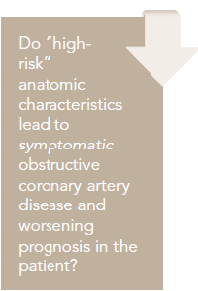Publication
Article
Cardiology Review® Online
A Comparison of Fractional Flow Reserve by Coronary Angiography Vs. Atherosclerotic Plaque Characteristics by Coronary CTA
Author(s):
In the era of progressive technology, the diagnostic modalities for stable coronary artery disease are various. The original cardiac stress test has been used in the past for many purposes, including diagnosis of obstructive coronary artery disease in a patient with chest pain as well as risk stratification for ischemia. More recently, coronary computed tomographic angiography (CCTA) has emerged as a great tool to diagnose anatomically obstructive coronary lesions. However, for the past few years, obtaining functional and physiologic data such as comparative fractional flow reserve (FFR) has become the gold standard for evidence of ischemia on CCTA similar to invasive angiography.

Rabab Mohsin, MD
Review
Park H-B, Heo R, Hartaigh B, et al. Atherosclerotic plaque characteristicsby CT angiography identify coronary lesions that cause ischemia: a direct comparison to fractional flow reserve. J Am Coll Cardiol. 2015;8:1-10.

In the era of progressive technology, the diagnostic modalities for stable coronary artery disease are various. The original cardiac stress test has been used in the past for many purposes, including diagnosis of obstructive coronary artery disease in a patient with chest pain as well as risk stratification for ischemia. More recently, coronary computed tomographic angiography (CCTA) has emerged as a great tool to diagnose anatomically obstructive coronary lesions. However, for the past few years, obtaining functional and physiologic data such as comparative fractional flow reserve (FFR) has become the gold standard for evidence of ischemia on CCTA similar to invasive angiography.
If this data could be duplicated in a noninvasive test, it would further identify intermediate versus high-grade stenotic lesions. In 2011, the DeFACTO (Determination of Fractional Flow Reserve by Anatomic Computed Tomographic AngiOgraphy) study by Min et al2 determined the diagnostic accuracy by computed FFR in CCTA versus standard invasive coronary angiography. Nakazato et al also used the results from the DeFACTO study, and using computational methods obtained 3-dimensional coronary blood flow and simulated hyperemia with adenosine to determine FFR. They found higher sensitivity and high negative predicative value for intermediate lesionswith the addition of FFRCT.3
It is important to note that CCTA can also offer other anatomic values such as characteristics of plaque and atheromas. Whereas in invasive coronary angiography determining plaque characteristics is difficult to ascertain objectively even with intravascular ultrasound (IVUS), it is important to note that anatomic definitions that can be seen via CCTA may better determine plaque burden, atheromatous lesions, vascular remodeling, thin fibrous caps, necrotic lipid cores, and calcium.
However, it remains to be determined if “high-risk” anatomic characteristics lead to symptomatic obstructive coronary artery disease andworsening prognosis in the patient. Thus, Park et al studied patients in the DeFACTO study and further gathered this information, as it compares with functional and physiologic data such as ischemia with standard FFR in invasive coronary angiography.
Study Details
In this study the authors determined whether lesion ischemia as shown by FFR in coronary angiography compares with multiple anatomical characteristics defining plaque.
DeFACTO was a prospectively designed 17-center, multinational study. In this study, 252 stable patients had undergone CCTA followed by invasive coronary angiography within 60 days. A total of 407 coronary lesions were evaluated. The original study had exclusion criteria of any prior revascularization, contraindication to adenosine, recent acute coronary syndrome, complex congenital heart disease, priorimplantation of an intracardiac device such as pacemaker or defibrillator, any prosthetic heart valve, prior arrhythmia, serum creatinine level >1.5 mg/dL, allergy to iodinated contrast, pregnancy, bodymass index >35 kg/m2, evidence of active life-threatening disease, or inability toadhere to study procedures. FFR by coronary angiography was measured in a blinded angiographic core laboratory of angiographic lesions between 30% and 90%.
After administration of nitroglycerin, adenosine was used for maximal hyperemia, and significant FFR cutoff was 0.8 or less. The lesions that had FFR by coronary angiography also were analyzed by CCTA in a blinded manner. For CCTA, a 64-multislice detector with standard reconstruction and phase imaging was obtained for the slices that depicted the least amount of coronary artery motion. Blinded expert readers analyzed the CT scans; anything >1mm2 if intraluminal of the vessel was considered atherosclerotic. CT qualitative data included presence of positive remodeling (PR), low attenuation plaque (LAP), and spotty calcification (SC). CT quantitative data included lesion length, lumen area stenosis, plaque volume, and percent aggregate plaque volume.
Of the 407 lesions in the study, 53% were labeled as obstructive (CT stenosis>50%). The mean FFR value was 0.82 + 0.13.The authors found that higher stenosis, longer lesion length, larger plaque volume, higher aggregate plaque volume, and higher rates of PR, LAP, and SC were associated with lesions that caused ischemia. PR, LAP (CT surrogate for a necrotic lipid core), spotty calcification, and increasing numbers of intraplaque characteristics were associated with ischemia for both >50% and <50% stenotic coronary lesions by CCTA. In fact, positive remodeling was especially significant for ischemia. On the other hand,spotty calcification was not associated with ischemia for both >50% and <50% stenotic coronary lesions by CCTA. Univariable and multivariable analysis was undertaken with obstructive versus nonobstructive lesions in different models (quantitative versus qualitative).
In conclusion, the study found a strong correlation between the number of atherosclerotic plaque characteristics and type, especially for positive remodeling, and lesion-specific ischemia even if <50% of CT stenotic lesions do not meet conventional thresholds of invasive angiographic severity. An interesting finding from the study was evidence of ischemia (17%) in the <50% CT stenotic group. The quantitative measures undertaken in the study also correlated with ischemia; however, they were more significant for the obstructive stenotic lesion group.
Commentary
A novel approach to studying stable CAD
The novel approach taken in this study for stable coronary artery disease patients gives practicing physicians a new approach to identifying lesions in obstructive coronary artery disease (CAD) that cause ischemia. The degree of stenosis as noted by CCTA is a noninvasive clue to not only diagnosing CAD but now with the quantitative and qualitative identifiers that the authors used can show anatomic and physiologic characteristics of patients that have ischemia and prognosticate future cardiovascular events.
The paper by Park et al has cast light on many important issues in establishing the benefit of obtaining a noninvasive test for risk stratification of stenotic lesions as well as diagnosing the degree of stenotic vessels and avoiding angiography. Defining objective findings on CCTA is relatively new in noninvasive imaging. In 2011, Min et al published results from the famous ACCURACY trial, which looked at lesions of 230 patients with CCTA and characterized plaque descriptions of >50% stenosis—in other words, a plaque scoring system. The plaque scoring system in earlier trials with CCTAwasdesigned to determine if there was a correlation between acute coronary syndromes in patients with significant plaque burden andfuture major adverse cardiovascular events. Most systems usually scored erosions, luminal stenosis, and positive remodeling.5ACCURACY was a landmark, a prospectively designed multicenter trialthat saw higher prevalence of mixed plaque features in obstructive CAD.4 In the past few years, ACCURACY has been followed up with better qualitative measurements for plaque characteristics by coronary CTA, as Park et al noted.
Another important aspect of CCTA is the ability to follow stenotic lesions for risk stratification and prognosis of disease without resorting to more invasive techniques and higher procedural risks for patients. CCTA meets prognostic criteria such as identifying very low-risk patients and determining management for those with obstructive disease in a quick and timely manner.6 In the article by Munner et al, the authors postulated that predicting ACS was based largely on anatomic burden, not ischemia. The future of predicting acute coronary syndromes lies, then, in the process of identifying “vulnerable plaque.”6
Several of the study’s limiting factors are important to mention. CCTA carries its own increasing limitations such as high radiation, cost, need for expert readers in high-volume centers, technical problems, and computational and radiographic restrictions such as poor spatial resolution. The debate over using new noninvasive testing as opposed to conventional modalities will continue. The recent critique for the PROMISE trial, in which CCTA was used to diagnose without physiologic characteristics, may change if using plaque and atherosclerotic descriptors comes into mainstream imaging.
Recently the authors of the PROMISE trial found that symptomatic patients with suspected CAD using anatomical CCTA show similar outcomes to functional stress testing with exercise. The trial gained momentum and caused debate due to recent data showing that anatomic stress testing is not better than functional testing.However, PROMISE did not reduce cardiac events or improve clinical outcomes in a 2-year follow-up.1 CCTA is an advantage to the clinician; however, a selective group of patients will need to be assessed for this chosen noninvasive test.
References
1. Douglas PS, Hoffman U, Patel MR,et al. Outcomes of anatomical versus functional testing for coronary artery disease. NEngl JMed. 2015;372:1291-1300.
2. Min JK,Berman DS, Budoff MJ, et al. Rationale and design of the DeFACTO (Determination of Fractional Flow Reserve by Anatomic Computed Tomographic AngiOgraphy) study.JCardiovascComputTomogr.2011;5:301-309.
3. Nakazato R, et al. Non-invasive fractional flow reserve derived from CT angiography forcoronary lesions of intermediate stenosis severity: results from the DeFACTO study.Circ Cardiovasc Imaging. 2013;6:881-889.
4. Min JK, Edwardes M, Lin FY, et al. Relationship of coronary artery plaque composition to coronary artery stenosis severity: results from the prospective multicenter ACCURACY trial.Atherosclerosis.2011;219:573-578.
5. He B, Gai L, Gai J, et al. Correlation between major adverse cardiac events and coronary plaque characteristics. Exp Clin Cardiol. 2013;18:e71-e76.
6. Munnur RK, Cameron JD, Ko BS, et al. Cardiac CT: atherosclerosis to acute coronary syndrome. Cardiovasc Diagn Ther. 2014;4:430-448.
About the Author
Rabab Mohsin, MD, is a cardiology fellow at Texas Tech Medical Center in El Paso, Texas. She is board certified in Internal Medicine. Dr Mohsin received her MD from Ross University School of Medicine, Dominica, West Indies, and completed a residency in internal medicine at the University of Kentucky in Lexington, where she participated in cardiac research protocols. She has published multiple abstracts on atrial fibrillation, obesity, and anticoagulation.





